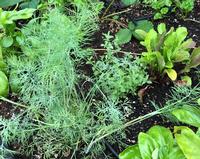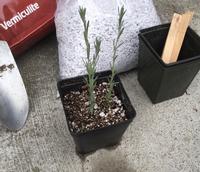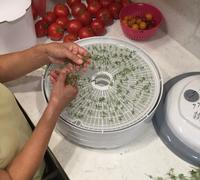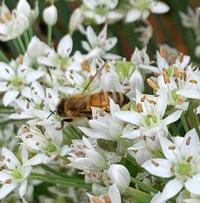Herb Gardening Basics
Top tips for a successful herb garden
- Choose a sunny location with well drained soil. Herbs generally need full sun
- Group herbs according to similar watering needs
- Perennial herbs generally require no fertilization
- Utilize containers to grow herbs on a patio, or even indoors
- Herbs can be preserved or dried for use well past the growing season
Annual and perennial herbs
Herbs are generally classified as:
Annual - a plant that completes its life cycle in a single season
Biennial - a plant that takes two years to complete its life cycle
Perennial - a plant that can live for many years. Perennials may be evergreen, such as rosemary, or may die back then resprout from the roots, such as mint or tarragon. The latter type is called a tender perennial
How to grow
Sun Exposure: Herbs generally do best in full sun, although there are some that will tolerate partial shade.
Soil: Plant needs vary, but in general herbs appreciate soil that has been amended with adequate amounts of organic matter or compost. Good drainage is also critical, especially with many of the perennial herbs. Wet, poorly drained soils, particularly over the winter, will shorten the useful life of many perennial herbs. If the area selected for growing herbs is poorly drained, consider building raised beds.
Watering: Herb requirements for water vary enormously, from those that survive with no summer water at all to those which require consistently moist soil. When planting an herb garden, it's essential to group herbs according to their water needs.
Fertilization: Fertilize annual and biennial herbs as you would vegetables. Perennial herbs generally require no fertilization.
Propagation by stem cuttings
One of the most important methods for propagating herbs is via stem cuttings. The three most useful types of stem cuttings are herbaceous, softwood, and semi-hardwood cuttings. These terms reflect the growth stage of the plant, so naturally follow the seasonal growth cycle of the parent plant.
Herbaceous cuttings are made from herbs that do not have woody stems. They can be taken any time the plant is actively growing. A high percentage of these cuttings root successfully, and they do so relatively quickly.
Examples: Basil, mint
Softwood cuttings are prepared from the soft, succulent new growth of woody plants, just as the stem begins to harden. For woody herbs this will generally be in spring. Suitable shoots can be snapped easily when bent, and should feature both mature older leaves, as well as small new leaves. Softwood cuttings typically take 2–5 weeks to root.
Examples: Rosemary, lavender
Semi–hardwood cuttings are prepared from the partially mature wood of the current season’s growth, after the growth flush is completed. Semi–hardwood cuttings are usually successful from mid-summer to early fall. Rooting typically takes 4–6 weeks.
Examples: Marjoram, thyme, rosemary
Procedure for rooting stem cuttings:
- Prepare your rooting medium. For best results, a rooting medium is sterile, low in fertility, drains well, and retains moisture. An example of an acceptable rooting medium is a mix of equal parts peat, vermiculite, and perlite. Many other mixtures are possible
- Take 4–6" cuttings with a sharp knife, clippers, or razor blade to reduce injury to the parent plant. Between cuttings, dip the cutting tool in rubbing alcohol or a solution of 1 part bleach to 9 parts water to prevent the transmittal of diseases
- Remove any flowers and buds. Remove the leaves from the lower 2" of the cut stem
- Cuttings, except those from soft, fleshy stems, may be dipped in a rooting hormone to speed rooting, increase the number of roots, or obtain uniform rooting. Follow the label directions when using a rooting hormone
- Insert cuttings into the moistened rooting medium. Place in bright, indirect light
- Transplant your new plants to the garden when well rooted
Patio or container herb gardening
Most herbs can be easily grown in containers. Be sure to use a container with drainage holes and fill it with a good quality potting mix. For more information, see Container Gardening Basics.
Growing herbs indoors
Many herbs can be grown indoors as year-round houseplants. Most herbs will still need at least six hours of bright light from a sunny window or 12–16 hours of supplemental light provided by cool white fluorescent or LED lamps. For more information, see Growing Herbs Indoors.
Preserving and drying herbs
Freezing: Good for herbs that lose too many aromatics when dried, such as basil and dill. Wash herbs and pat dry; freeze in airtight bags. To store for longer than 2 months, blanch in boiling water for 45 seconds before drying. Herbs can also be mixed with oil, butter, or made into condiments such as pesto before freezing.
Drying: When leaves crumble easily between your fingers, they are dry enough. Dried herbs can be kept for 2–3 years, but for best flavor use within one year. Store in air tight containers in a cool, dry place away from sunlight. Crush or grind just before use.
Simple drying: Arrange leaves in a single layer on a paper towel or suspended window screen, out of direct sun, for 1 week.
Air drying: Tie small bunches of herbs with rubber bands. Hang upside down in a dark, well ventilated room for 2–3 weeks.
Oven drying: Place leaves in a single layer on a cookie sheet, at lowest temperature setting with oven door ajar, until dry.
Microwave: Arrange herbs in single layer between 2 dry paper towels. Microwave on high for 1–2 minutes, stirring every 30 seconds. Reheat for 30 seconds at a time until dry and brittle.
Dehydrator: Follow manufacturer's directions.
For more information, see Culinary Herbs.
Herbs to attract pollinators
Flowering herbs are a great source of much-needed nectar for our important pollinators. Attracting pollinators is beneficial to your vegetable garden, as well. In fact, the University of California recommends that a garden contain at least 20 different types of flowering plants in order to provide resources for the various bee species throughout the year.Some of the best herbs to attract pollinators are lavender, rosemary, and sage. For more information, see How to Attract and Maintain Pollinators in Your Garden.
Collecting herb seeds
Let the flowers mature until the seed pods turn brown. Then cut the stems and loosely combine them into small bundles with kitchen string or rubber bands. Do not bunch them tightly, or mold may occur. Hang the bunches upside down in a dark, warm, dry place with good air circulation. Loosely tie a paper bag over the flower heads, or place a clean cloth under the drying herbs to catch any falling seeds.
Seeds should be stored in airtight glass jars and kept in a cool, dry location out of the light. Shelf life should be about one year.
Pest management for herbs
Most herbs are fairly problem free, but there are a few pests and diseases to watch for. Here are links for some common pests and diseases:
Useful links
California Master Gardener Handbook, UC Agriculture and Natural Resources
Culinary Herbs, UCCE Master Gardeners of Santa Clara County
Growing Herbs Indoors, Penn State Extension Master Gardener Program, Pennsylvania State University
Grow herbs!, UCCE Master Gardeners of Sacramento County
Culinary Herbs, University of Kentucky Cooperative Extension Service
Drying Herbs, UCCE Master Gardeners of Sonoma County
How to Attract and Maintain Pollinators in Your Garden, University of California Agriculture and Natural Resources.
Propagation, North Carolina Extension Gardener Handbook.










